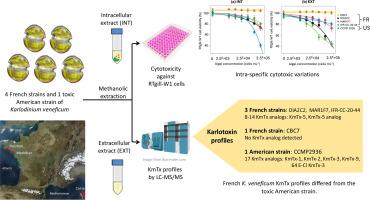法国水域Karlodinium veneficum (Dinophyceae)菌株对鱼鳃细胞的体外鱼毒性及产毒的研究
IF 4.5
1区 生物学
Q1 MARINE & FRESHWATER BIOLOGY
引用次数: 0
摘要
在法国沿海水域经常检测到甲藻;然而,法国菌株的鱼毒性潜力及其产生卡洛毒素(KmTxs)的能力尚不清楚。本研究旨在利用RTgill-W1虹鳟鱼鳃细胞系,比较四种法国菌株和一种美国菌株(此处用作参考)的生物活性和KmTx谱。采用瑞唑脲法、乳酸脱氢酶(LDH)释放、线粒体膜电位(TMRE染料)检测甲醇提取物中细胞内毒素和可释放毒素(INT, EXT)的影响,同时采用液相色谱-质谱联用检测KmTxs。细胞毒活性因菌株和馏分而异,IFR-CC-20-44 EXT(法国)和CCMP 2936 INT(美国)毒性最大,而CBC7(法国)无毒性。与美国菌株相比,法国菌株普遍表现出不同的细胞毒性机制。毒株的KmTx谱显示出出乎意料的高化学多样性,共检测到93个KmTx样分子。三个法国菌株具有相似的KmTx谱,以KmTx-5和KmTx-5类似物为主。相比之下,美国CCMP 2936的KmTx谱与法国菌株完全不同,没有共同的KmTx。有趣的是,无毒菌株CBC7没有产生任何kmtx。然而,在其他菌株中,其提取物的细胞毒性与总KmTx含量之间没有明确的联系。这可能反映了KmTx类似物之间的效力差异,尽管不能排除其他未表征的化合物的参与。本文章由计算机程序翻译,如有差异,请以英文原文为准。

Insights into the in vitro ichthyotoxicity on fish gill cells and toxin production of Karlodinium veneficum (Dinophyceae) strains from French waters
The dinoflagellate Karlodinium veneficum is regularly detected in French coastal waters; however, the ichthyotoxic potential of French strains and their ability to produce karlotoxins (KmTxs) remain unclear. This study aims to compare the bioactivity and KmTx profiles of four French strains and one previously characterized American strain of K. veneficum (used here as a reference), using the RTgill-W1 rainbow trout gill cell line. Both intracellular and releasable toxins (INT, EXT) in methanolic extracts were assessed for their effects using a resazurin-based assay, lactate dehydrogenase (LDH) release, mitochondrial membrane potential (TMRE dye), while liquid chromatography coupled to mass spectrometry was used to detect KmTxs. Cytotoxic activity varied depending on the strain and fraction, with IFR-CC-20–44 EXT (French) and CCMP 2936 INT (American) being the most toxic, while CBC7 (French) showed no toxicity. The French strains generally exhibited different cytotoxic mechanisms compared to the American strain. The KmTx profiles of the toxic strains showed an unexpectedly high chemodiversity with 93 KmTx-like molecules detected. Three French strains had similar KmTx profiles, dominated by KmTx-5 and a KmTx-5 analog. In contrast, the KmTx profile of the American CCMP 2936 was completely different to the French strains, with no KmTx in common. Interestingly, strain CBC7, which was non-toxic, did not produce any KmTxs. However, among the other K. veneficum strains, no clear link was established between the cytotoxicity of their extracts and total KmTx content. This may reflect differences in potency among KmTx analogs, although the involvement of other uncharacterized compounds cannot be excluded.
求助全文
通过发布文献求助,成功后即可免费获取论文全文。
去求助
来源期刊

Harmful Algae
生物-海洋与淡水生物学
CiteScore
12.50
自引率
15.20%
发文量
122
审稿时长
7.5 months
期刊介绍:
This journal provides a forum to promote knowledge of harmful microalgae and macroalgae, including cyanobacteria, as well as monitoring, management and control of these organisms.
 求助内容:
求助内容: 应助结果提醒方式:
应助结果提醒方式:


